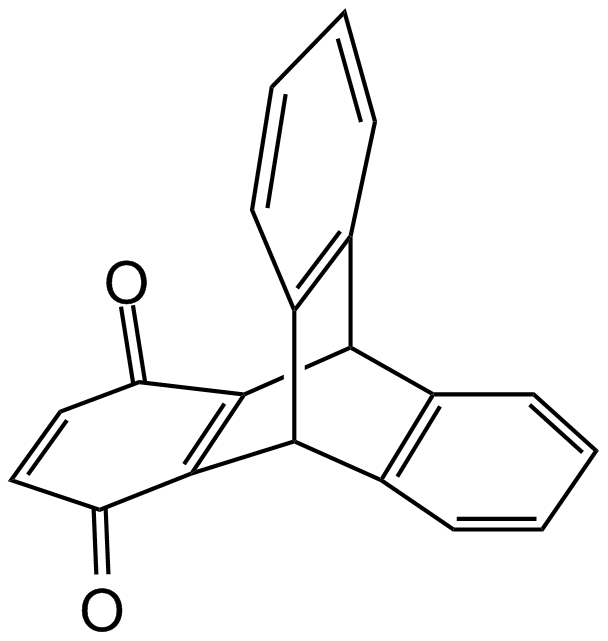INCA-6 (Synonyms: Triptycene-1,4-quinone) |
| Catalog No.GC16117 |
A cell-permeant inhibitor of NFAT signaling
Products are for research use only. Not for human use. We do not sell to patients.

Cas No.: 3519-82-2
Sample solution is provided at 25 µL, 10mM.
INCA-6 is a selective inhibitor of transcription factor NFAT with Kd value of 0.8 mM in vitro[1].
NFAT (Nuclear factor of activated T-cells) is a general name which is applied to a family of transcription factors that are important in immune response. They are expressed in most immune system cells. Calcium signaling plays an important role in NFAT activation. Calmodulin activates calcineurin (CN) which is a serine/threonine phosphatase, then dephosphorylates the amino termini of NFAT proteins resulting a conformational change. NFAT will transport into nuclear. NFAT proteins will cooperate with other nuclear resident transcription factors due to that they have weak DNA-binding capacity. NFAT proteins have weak DNA-binding capacity NFAT transcription factors are specifically implicated in the process of cell motility and are related to breast cancer.[2]
INCA-6 treatment significant blocked translocation of nuclear factor of activated T-cells c1. INCA-6 effectively blocked the stimulation of vascular endothelial growth factor stimulation at 1.0 μM. INCA-6 significantly tube formation at 1.0μM in human retinal microvascular endothelial cells[1]. INCA-6 at 50 μM inhibited ATP-induced activation of NFATc1 in MG-5 cells.[3] In BV-2 cells, INCA-6 at 10
μM significantly inhibited ATP-induced CXCL2 expression.[4] INCA-6 reversed the proliferative effect of E2.[5]
References:
[1]. Bretz CA, Savage S, Capozzi M, Penn JS: The role of the NFAT signaling pathway in retinal neovascularization. Invest Ophthalmol Vis Sci 2013, 54(10):7020-7027.
[2]. Crabtree GR, Olson EN: NFAT signaling: choreographing the social lives of cells. Cell 2002, 109 Suppl:S67-79.
[3]. Kataoka A, Tozaki-Saitoh H, Koga Y, Tsuda M, Inoue K: Activation of P2X7 receptors induces CCL3 production in microglial cells through transcription factor NFAT. J Neurochem 2009, 108(1):115-125.
[4]. Shiratori M, Tozaki-Saitoh H, Yoshitake M, Tsuda M, Inoue K: P2X7 receptor activation induces CXCL2 production in microglia through NFAT and PKC/MAPK pathways. J Neurochem 2010, 114(3):810-819.
[5]. Wong CK, So WY, Law SK, Leung FP, Yau KL, Yao X, Huang Y, Li X, Tsang SY: Estrogen controls embryonic stem cell proliferation via store-operated calcium entry and the nuclear factor of activated T-cells (NFAT). J Cell Physiol 2012, 227(6):2519-2530.
Average Rating: 5 (Based on Reviews and 30 reference(s) in Google Scholar.)
GLPBIO products are for RESEARCH USE ONLY. Please make sure your review or question is research based.
Required fields are marked with *




















